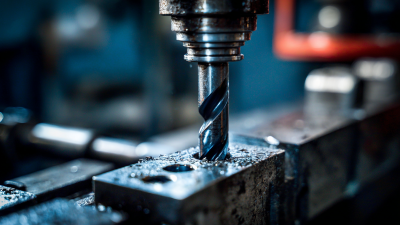In the ever-evolving world of construction and manufacturing, the tools we use significantly impact our productivity and efficiency. One such innovation is the Carbide Grit Hole Saw, engineered specifically for cutting tough materials such as tile, glass, and masonry. According to recent industry reports, the global market for hole saws is projected to grow at a CAGR of over 5% from 2022 to 2027, driven by an increasing demand for precision in drilling applications. The Carbide Grit Hole Saw stands out due to its superior durability and cutting performance, allowing professionals to achieve cleaner cuts and reduce downtime. By harnessing the advanced features of carbide grit, users not only enhance their drilling efficiency but also extend the lifespan of the saw, making it a vital tool in any tradesperson's arsenal.

A carbide grit hole saw is an essential tool designed for drilling through hard materials, making it invaluable in modern drilling applications. Unlike traditional hole saws that are primarily used for softer materials, carbide grit hole saws utilize a robust coating of carbide granules that provide superior cutting capabilities. This unique feature allows them to effortlessly slice through tough substances such as ceramic tiles, concrete, and stone. As a result, professionals in construction, plumbing, and electrical fields often prefer carbide grit hole saws for their durability and efficiency.
 The primary purpose of a carbide grit hole saw lies in its ability to enhance drilling efficiency. When working on projects that require precision and speed, these tools excel due to their exceptional cutting ability and heat resistance. This means that users can achieve cleaner cuts with less risk of damaging the surrounding material. Ultimately, the use of carbide grit hole saws not only saves time but also reduces the wear on the drill bits, thus extending their lifespan and ensuring consistent performance. Whether you are a contractor or a DIY enthusiast, incorporating carbide grit hole saws into your toolkit can significantly improve your drilling tasks.
The primary purpose of a carbide grit hole saw lies in its ability to enhance drilling efficiency. When working on projects that require precision and speed, these tools excel due to their exceptional cutting ability and heat resistance. This means that users can achieve cleaner cuts with less risk of damaging the surrounding material. Ultimately, the use of carbide grit hole saws not only saves time but also reduces the wear on the drill bits, thus extending their lifespan and ensuring consistent performance. Whether you are a contractor or a DIY enthusiast, incorporating carbide grit hole saws into your toolkit can significantly improve your drilling tasks.
Carbide grit hole saws are rapidly becoming the preferred choice for both professional contractors and DIY enthusiasts, offering significant advantages over traditional drill bits. These specialized saws are designed for cutting through tough materials such as tile, fiberglass, and metal with precision and efficiency. Unlike conventional bits, carbide grit hole saws feature a robust abrasive edge that makes them ideal for high-performance drilling tasks. Their durability not only enhances the quality of cuts but also extends tool life, making them a economical choice for those frequently engaged in heavy-duty projects.
One of the primary advantages of carbide grit hole saws is their ability to retain sharpness despite prolonged use, which translates into less frequent replacements. This trait not only reduces costs but also minimizes downtime, allowing users to maintain a smoother workflow. Additionally, their design permits faster cutting speeds while producing less heat, which can often compromise the integrity of materials. For those looking to optimize drilling efficiency without sacrificing quality, carbide grit hole saws represent a significant evolution in drilling technology that meets the demands of modern construction and fabrication tasks.
| Feature | Carbide Grit Hole Saw | Traditional Drill Bit |
|---|---|---|
| Material Composition | Carbide grit for enhanced durability | High-speed steel or coated steel |
| Cutting Efficiency | Faster cutting through hard materials | Slower cutting in tough materials |
| Longevity | Long-lasting with reduced wear | Shorter lifespan due to wear and tear |
| Heat Resistance | High heat resistance, minimizing overheating | Generally lower heat resistance |
| Ideal Applications | Masonry, ceramics, and hard metals | Wood, plastic, and soft metals |
| Cost | Higher initial investment | Lower initial cost |
Carbide grit technology has revolutionized the way we approach drilling, significantly enhancing both cutting speed and tool longevity. Traditional hole saws often struggle with tough materials, wearing down quickly and leading to frequent replacements.
 In contrast, carbide grit hole saws utilize a unique bond of carbide particles that are both exceptionally hard and durable. This advanced composition allows for a more aggressive cut, enabling users to drill through materials that would typically diminish the lifespan of ordinary tools, such as metal, ceramic, and hard plastics.
In contrast, carbide grit hole saws utilize a unique bond of carbide particles that are both exceptionally hard and durable. This advanced composition allows for a more aggressive cut, enabling users to drill through materials that would typically diminish the lifespan of ordinary tools, such as metal, ceramic, and hard plastics.
One of the standout features of carbide grit hole saws is their ability to maintain cutting performance over extended periods. Unlike standard bi-metal or high-speed steel saws that can lose sharpness and effectiveness rapidly, carbide grit saws retain their cutting edge, reducing the need for constant replacements and downtime. This not only streamlines the drilling process but also results in cost savings for professionals and DIY enthusiasts alike. The improved cutting speed means less time spent on project completion, making carbide grit hole saws an essential tool for anyone looking to boost their drilling efficiency and achieve superior results.
Carbide grit hole saws are rapidly gaining recognition for their exceptional efficiency across various materials in the drilling industry. Recent industry data indicates a significant rise in performance metrics when using these specialized tools compared to traditional saws. For instance, contractors reported faster drilling times and reduced material wear when utilizing carbide grit hole saws, making them a game changer in environments demanding precision and speed.
The materials being worked with—ranging from plywood to metal—showcase the versatility and enhanced efficiency of carbide grit hole saws. These tools not only increase the rate of hole penetration but also minimize the heat generated during cutting, which can prolong tool life and maintain operational integrity. As the construction and manufacturing sectors continue to evolve, the adoption of carbide grit technology plays a crucial role in meeting the rising demand for efficiency and quality outputs. Investing in these innovative tools could be the key to staying competitive in a market that increasingly values productivity and precision.
Carbide grit hole saws are increasingly recognized for their ability to enhance drilling efficiency, particularly in demanding applications such as aerospace. To maximize the performance of these tools, it is essential to implement best practices that capitalize on their unique characteristics. For instance, utilizing optimal drilling parameters—such as speed and feed rates—can significantly influence hole quality and the longevity of the saw. Recent studies indicate that a gradual increase in feed rate can minimize drilling forces, leading to improved chip formation and less tool wear, ultimately fostering a more productive drilling process.
Furthermore, the importance of proper tool geometry and coatings cannot be overlooked. Coating technologies have advanced, providing enhanced surface properties that reduce friction and decrease thermal effects during drilling operations. According to a review focused on aluminium alloys, the choice of coating can impact hole quality by reducing burr formation and improving surface finish, particularly critical in aerospace manufacturing where precision is paramount. By integrating these best practices alongside modern carbide grit hole saws, operators can achieve higher efficiency and quality in their drilling tasks, ensuring that they stay competitive in an evolving market.







